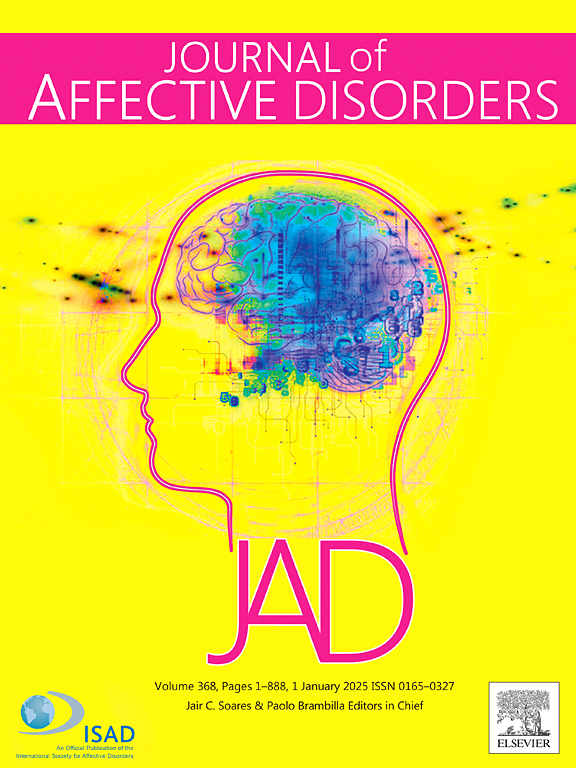Differential patterns of emotion regulation in sexual minority adolescents in residential treatment
IF 4.9
2区 医学
Q1 CLINICAL NEUROLOGY
引用次数: 0
Abstract
Objective
Sexual minority adolescents experience disproportionate mental health problems, including increased anxiety, depression, and suicidal thoughts and behaviors. Minority Stress Theory posits that sexual minority people experience significantly more stress (e.g., via discrimination or prejudice) in their everyday lives, which can underlie these mental health disparities. Though group differences in mental health symptoms are well-documented, there has been less focus on symptom trajectories, which is critical for identifying effective mental health interventions.
Method
Seventy adolescents ages 13–19 years enrolled in a short-term, acute residential psychiatric treatment program provided self-report measures of depressive symptoms, anxiety, and emotion regulation difficulties at baseline, discharge (∼2 weeks), and one-month post-treatment follow-up. Adolescents self-reported sexual orientation and were stratified into sexual minority (SM, n = 37) or heterosexual (n = 33) groups.
Results
Depressive and anxiety symptoms and emotion dysregulation scores were significantly reduced at follow-up, compared to baseline. While there were no significant group x time interactions for depressive and anxiety symptoms, the SM group entered the program with worse emotion dysregulation scores, which improved more over time compared to the heterosexual group.
Conclusion
These findings show that although sexual minority individuals can make substantial gains during residential treatment, emotion regulation difficulties are a particularly relevant treatment target. Emotion regulation, a transdiagnostic construct that typically develops substantially during adolescence, might be of critical importance when identifying effective treatment interventions for sexual minority youth.
Limitations
Adolescents in this sample demonstrated limited racial diversity and likely displayed a higher degree of psychopathology than the general population.
接受住院治疗的性少数群体青少年的情绪调节模式差异。
目的:性取向属于少数群体的青少年会遇到过多的心理健康问题,包括焦虑、抑郁、自杀想法和行为的增加。少数群体压力理论(Minority Stress Theory)认为,性少数群体在日常生活中承受的压力(如歧视或偏见)要大得多,这可能是造成这些心理健康差异的原因。虽然心理健康症状的群体差异已得到充分证实,但对症状轨迹的关注却较少,而这对于确定有效的心理健康干预措施至关重要:方法:70 名年龄在 13-19 岁的青少年参加了一个短期、急性住院精神病治疗项目,他们在基线、出院(约 2 周)和治疗后一个月的随访中提供了关于抑郁症状、焦虑和情绪调节困难的自我报告测量。青少年自我报告了性取向,并被分为性少数群体(SM,n = 37)或异性恋群体(n = 33):结果:与基线相比,随访时的抑郁症状、焦虑症状和情绪失调得分明显降低。虽然在抑郁症状和焦虑症状方面没有明显的组别 x 时间交互作用,但性少数群体组在参加项目时的情绪失调得分较低,而随着时间的推移,他们的情绪失调得分比异性恋组有了更大的改善:这些研究结果表明,虽然性少数群体在住院治疗期间可以取得很大进步,但情绪调节障碍是一个特别相关的治疗目标。情绪调节是一种跨诊断结构,通常在青春期有很大发展,在确定针对性少数群体青少年的有效治疗干预措施时,情绪调节可能至关重要:局限性:该样本中的青少年种族多样性有限,其精神病理学程度可能高于普通人群。
本文章由计算机程序翻译,如有差异,请以英文原文为准。
求助全文
约1分钟内获得全文
求助全文
来源期刊

Journal of affective disorders
医学-精神病学
CiteScore
10.90
自引率
6.10%
发文量
1319
审稿时长
9.3 weeks
期刊介绍:
The Journal of Affective Disorders publishes papers concerned with affective disorders in the widest sense: depression, mania, mood spectrum, emotions and personality, anxiety and stress. It is interdisciplinary and aims to bring together different approaches for a diverse readership. Top quality papers will be accepted dealing with any aspect of affective disorders, including neuroimaging, cognitive neurosciences, genetics, molecular biology, experimental and clinical neurosciences, pharmacology, neuroimmunoendocrinology, intervention and treatment trials.
 求助内容:
求助内容: 应助结果提醒方式:
应助结果提醒方式:


